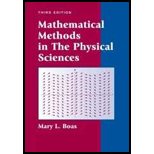
Concept explainers
Given
(a)
(b) a unit
(c) a vector in the direction of most rapid increase of
(d) the magnitude of the vector in (c);
(e) the derivative of
Want to see the full answer?
Check out a sample textbook solution
Chapter 6 Solutions
Mathematical Methods in the Physical Sciences
Additional Math Textbook Solutions
Calculus for Business, Economics, Life Sciences, and Social Sciences (13th Edition)
Probability and Statistics for Engineers and Scientists
A Problem Solving Approach To Mathematics For Elementary School Teachers (13th Edition)
Finite Mathematics & Its Applications (12th Edition)
Mathematics All Around (6th Edition)
Fundamentals of Differential Equations and Boundary Value Problems
- Find an equation of the tangent line to the parabola y=3x2 at the point 1,3.arrow_forwardView the curve (y - x)² + 2 = xy-3 as a contour of f(x, y). (a) Use f(-3, -2) to find a vector normal to the curve at (-3, -2). (b) Use your answer to part (a) to find an implicit equation for the tangent line to the curve at (-3, -2).arrow_forward2. 5 If the directional derivative value (Duf) of the function + (xry) = x²-3x4 + 4y at Point (-2,0) in direction of a unit vector (U=Ai+Bj) is ² and its value at Point (302) in the same direction is 261, find the unit Vector (U) then find value of the directional derivative (Duf) in the direction of the unit vector (u) at the point (11). 5 fir n nuarrow_forward
- For the curve C given by r(t) =< 5t,2 cos(t),2 sin(t) >, find: (a) the unit tangent vector to the curve C at the point (0,2,0) (leave your answer in exact form); (b) a vector equation for the tangent line to the curve C at the point (0,2,0) (leave your answer in exact form).arrow_forwardFind the directional derivative of function f(x.y}=x°e° at the point (1,1) and direction of vector v=21.arrow_forwardFor the curve C given by r(t) =< 5t, 2 cos(t), 2 sin(t) >, find: (a) the unit tangent vector to the curve C at the point (0, 2, 0) (leave youranswer in exact form);(b) a vector equation for the tangent line to the curve C at the point (0, 2, 0)(leave your answer in exact form).arrow_forward
- Find the directional derivative of the function at the given point in the direction of the vector v. g(r, s) = tan-1(rs), (2, 1), v = 5i + 10j Dug(2, 1) =arrow_forwardFind both the parametric and vector equation of the line segment between (−2, 3) and (5, −1) where 0 ≤ t ≤ 1. Please show all your work.arrow_forwardCalculate the directional derivative of g(x, y, z) = x ln (y + z) in the direction v = = 5i − 6j + 6k at the point P = (4, e, e). Remember to use a unit vector in directional derivative computation. (Use symbolic notation and fractions where needed.) Dvg(4, e, e) =arrow_forward
- Algebra & Trigonometry with Analytic GeometryAlgebraISBN:9781133382119Author:SwokowskiPublisher:Cengage
 Trigonometry (MindTap Course List)TrigonometryISBN:9781337278461Author:Ron LarsonPublisher:Cengage Learning
Trigonometry (MindTap Course List)TrigonometryISBN:9781337278461Author:Ron LarsonPublisher:Cengage Learning

